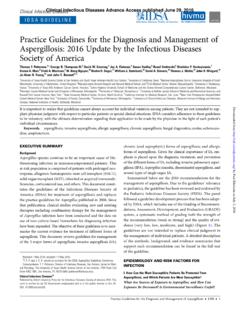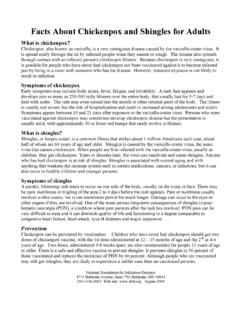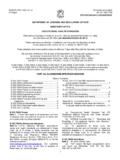Transcription of Guidance on regulations for the Transport of …
1 EPIDEMIC AND PANDEMICALERT AND RESPONSEG uidance on regulations fortheTransport of InfectiousSubstances2007 2008 Applicable as from 1 January 2007 WHO/CDS/ on regulations fortheTransport of InfectiousSubstances2007 2008 Applicable as from 1 January 2007 World Health Organization 2007 All rights designations employed and the presentation of the material in this publication do not imply theexpression of any opinion whatsoever on the part of the World Health Organization concerning the legalstatus of any country, territory, city or area or of its authorities, or concerning the delimitation of itsfrontiers or boundaries. Dotted lines on maps represent approximate border lines for which there may notyet be full mention of specific companies or of certain manufacturers products does not imply that they areendorsed or recommended by the World Health Organization in preference to others of a similar nature thatare not mentioned.
2 Errors and omissions excepted, the names of proprietary products are distinguished byinitial capital reasonable precautions have been taken by the World Health Organization to verify the informationcontained in this publication. However, the published material is being distributed without warranty of anykind, either express or implied. The responsibility for the interpretation and use of the material lies with thereader. In no event shall the World Health Organization be liable for damages arising from its extracts from the Recommendations on the Transport of Dangerous Goods, ModelRegulations, 14th revised edition, New York and Geneva, United Nations, 2005 arereproduced by kind permission of the United Guidance on regulations for the Transport of infectious substances 2007 Contents Introduction ..2 International National regulations ..3 Definitions and infectious Cultures.
3 4 Patient specimens ..4 Biological products ..5 Genetically modified microorganisms and organisms ..5 Medical or clinical wastes ..5 Exceptions ..5 General preparation of shipments for Basic triple packaging system ..7 Packaging, labelling and documentation requirements for infectious substances in Category A ..7 Packaging ..7 Marking ..9 Labelling ..9 Documentation ..11 Packaging, labelling and documentation requirements for infectious substances in Category B 13 Packaging ..13 Marking ..14 Documentation ..14 Overpacks ..15 Refrigerants ..15 Recommendations for countries that have not adopted the United Nations system ..16 Transport planning ..16 The shipper (sender, consignor) ..17 The carrier ..17 The receiver (consignee) ..17 Requirements for air mail ..17 Spill clean-up procedure ..18 Incident reporting ..18 Annex 1 Additional information on the United Nations System for the Transport of Dangerous Goods.
4 19 Annex 2 Examples of infectious substances included in Category Annex 3 Packing Instruction P620 ..22 Annex 4 Packing Instruction P650 ..23 Annex 5 Flowchart for the classification of infectious substances and patient specimens ..26 WHO/CDS/ Guidance on regulations for the Transport of infectious substances 2007 2 Introduction These guidelines provide practical Guidance to facilitate compliance with current international regulations for the Transport of infectious substances and patient specimens by all modes of Transport , both nationally and internationally, and include the changes that apply from 1 January 2007. They replace the guidelines issued by the World Health Organization (WHO) in 2005 (document WHO/CDS/CSR/ ). This publication, however, does not replace national and international Transport regulations .
5 The latest regulations are based on a completely new system and are no longer related to the Risk Group concept used until the end of 2004. The rationale for the new system is set out in document WHO/CDS/CSRL/ entitled Background to the amendments adopted in the 13th revision of the United Nations Model regulations guiding the Transport of infectious substances ( ). The following guidelines provide information for classifying infectious substances for transportation and ensuring their safe packaging. They stress the importance of developing a working relationship between those involved the sender, the carrier and the receiver in order to provide for safe and expeditious Transport of these materials. Postal, airline and other Transport industry personnel have concerns about the possibility of becoming infected as the result of exposure to infectious microorganisms that may escape from broken, leaking or improperly packaged material.
6 The packaging of infectious substances for Transport must therefore be designed to minimize the potential for damage during Transport . In addition, the packaging must ensure the integrity of the materials and so, in turn, timely and accurate processing of specimens. There are no recorded cases of illness attributable to the release of infectious substances or diagnostic specimens during Transport , although there are reported incidents of damage to improperly and sometimes even properly packaged materials. The shipment of unmarked and unidentified infectious substances, improperly packaged, obviously increases the overall potential for exposure to all persons. Damage to packaging also means that samples dispatched for analysis, generally an urgent task, are unlikely to arrive at their destination on time. International regulations The international regulations for the Transport of infectious substances by any mode of Transport are based upon the Recommendations made by the Committee of Experts on the Transport of Dangerous Goods (UNCETDG), a committee of the United Nations Economic and Social Council.
7 The Recommendations are presented in the form of Model regulations . The United Nations Model regulations are reflected in international law through international modal agreements (links to further information are provided in Annex 1): Air The Technical Instructions for the Safe Transport of Dangerous Goods by Air published by the International Civil Aviation Organization (ICAO) are the legally binding international regulations . The International Air Transport Association (IATA) publishes Dangerous Goods regulations (DGR) that incorporate the ICAO provisions and may add further restrictions (where necessary such restrictions are included in these guidelines). The ICAO rules apply on all international flights. For national flights, flights within one country, national civil aviation authorities apply national legislation.
8 This is normally based on the ICAO provisions, but may incorporate variations. State and operator variations are published in the ICAO Technical Instructions and in the IATA Dangerous Goods regulations . WHO/CDS/ Guidance on regulations for the Transport of infectious substances 2007 3 Rail regulations concerning the International Carriage of Dangerous Goods by Rail (RID) apply to countries in Europe, the Middle East and North Africa. RID also applies to domestic Transport in the 25 countries of the European Union through Council Directive 96/49/EC. Road The European Agreement concerning the International Carriage of Dangerous Goods by Road (ADR) applies to 40 countries. In addition, modified versions of the convention are being used by countries in South America and South-East Asia. ADR also applies to domestic Transport in the 25 countries of the European Union through Council Directives 94/55/EC.
9 Sea The International Maritime Dangerous Goods Code published by the International Maritime Organization (IMO) is of mandatory application for all 155 contracting parties to the International Convention for the Safety of Life at Sea (SOLAS). Post The Letter post manual published by the Universal Postal Union (UPU) reflects the United Nations Recommendations using the ICAO provisions as the basis for shipments. The World Health Organization serves in an advisory capacity to UNCETDG and ICAO. National regulations Many countries adopt the United Nations Model regulations in their entirety to stand as their national dangerous goods legislation. Some countries apply variations. National authorities should provide details of their own national requirements. Note: These guidelines are based on the 14th revised edition of the United Nations Recommendations on the Transport of Dangerous Goods, the text of which is reflected in the 2007 editions of the international modal regulations ( ICAO Technical Instructions for the Safe Transport of Dangerous Goods by Air, Doc 9284 AN/905, 2007-2008 Edition; ADR, European Agreement Concerning the International Carriage of Dangerous Goods by Road, applicable as from 1 January 2007) and in many sets of national legislation.
10 In December 2006, UNCETDG agreed on further changes for the 15th edition. These changes do not come into force until 2009. If, in the future, further modifications are made to the section of the United Nations Recommendations that deals with infectious substances and patient specimens, the WHO guidelines will be updated accordingly. Definitions and classification In describing Transport safety measures, the terms infectious substances and infectious materials are considered to be synonymous. The term infectious substances is used in this document. Text reproduced from the United Nations Model regulations is italicized. infectious substances For the purposes of Transport , infectious substances are defined as substances which are known or are reasonably expected to contain pathogens. Pathogens are defined as microorganisms (including bacteria, viruses, rickettsiae, parasites, fungi) and other agents such as prions, which can cause disease in humans or animals.

















